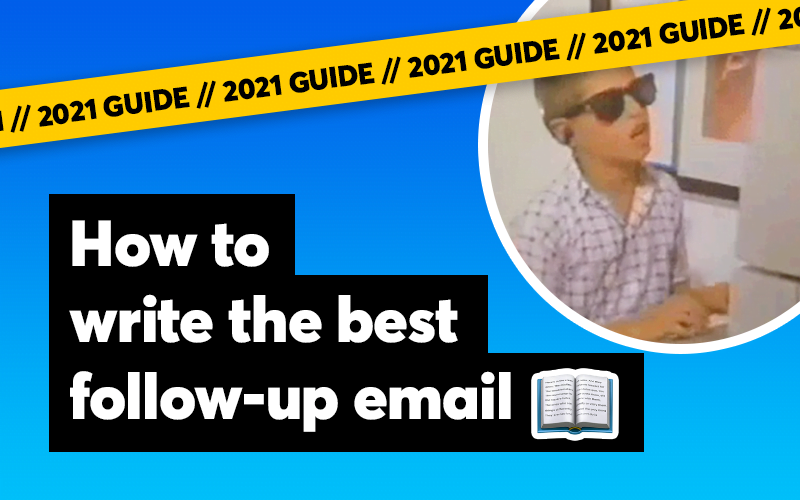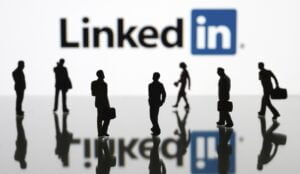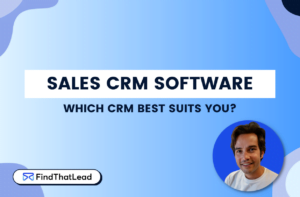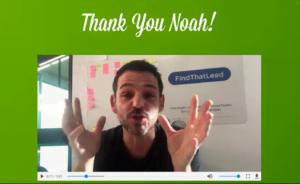Writing a follow-up email is one of the best ways to increase the conversion rate of your cold mailing campaigns.
However, to get good results you have to know what email to send and when. There is little point in sending a follow-up email or sending a follow-up email at the wrong time.
At FindThatLead we are experts in email campaigns. And after thousands of tests and experiments, we have discovered the keys to making your follow-up emails work and increasing the % of closed sales.
In this guide, I’m going to show you everything we know so that you too can close more sales and collaborations thanks to follow-up emails when you don’t receive a response.
Let’s check it out!
A Follow-up Email: Are you clear about what you are sending this email for?
Before sending a follow-up email to someone, you must have a goal, but also a reason. And you’ll say, what’s the difference between objective and motive? Let me explain:
- The objective is what you are pursuing with your email. For example: close a sale, schedule a video call, get a job, close a collaboration, etc.
- The motive, on the other hand, is the reason why you are sending the email and the reason why the recipient will want to reply to you. Ex: I am sending you my resume for the vacancy, I am sending you a special offer for you, I want to make a video call to discuss X aspect that can help you to improve the SEO of your website, etc.
As you can see, objective and motive are closely related. And it is very important that it is so.
When we send an email, we have to keep in mind that we are contacting a person, so it is very important to humanize, create a link with the other person and offer a compelling reason to the person who will read this email to answer us.
It will be of little use to send a cold email without personalizing, humanizing, and offering a reason for the recipient to reply.
If this is the first time you send a cold email to someone, I recommend that you follow this process to help you define your objective and the reason why the recipient will want to reply:
- Define the final objective of your email: to make my saas known, to close collaboration, and to sell my services as an agency.
- Define a buyer persona who should be the recipient of your email.
- Create a list of 5-10 ways to add value to the recipient of your email.
- Define in a 10-word sentence the main reason why the recipient will want to respond to your email.
- Write a follow-up email that provides value to the recipient and highlights the reason we have defined why they will want to respond to us.
If you have trouble trying to find anyone’s email, check this article
Follow-up email after not receiving a response: the importance of sending it with data
If you are still not convinced of how important it is to send a follow-up email, especially if you have not received a response from your prospect, I am going to show you some data that will make you say yes to sending emails:
- According to studies, each professional receives up to 120 emails a day. With such an amount of emails received, it is normal that you have not received a response to yours.
- Sending a follow-up email increases the opening rate of your emails by 63%.
- Sending a follow-up email increases by 52% the response to your emails.
- Follow-up emails or message flow allow you to close 23% more sales.
How to write a follow-up email
Once you have discovered the importance of sending follow-up emails to improve the performance of your cold email campaigns, let’s see how you need to write your follow-up email to get the expected results.
Throughout this section, we will first see what structure your follow-up email should have and then I will show you some real examples of successful follow-up emails.
How to write an unanswered follow-up email
You wake up on a Monday morning with the desire to shine. You send 50 cold emails providing value to your target audience. You think you’re going to succeed and you’re going to close at least 5 important collaborations for your company.
The days go by… and let’s see if you can guess: 0 RESPONSES.
Here, you only have two options left:
- Write off those contacts and lose your enthusiasm for your project.
- Send a follow-up email, add value and close the collaborations to launch your project.
If you’ve made it this far, I’m sure you’ve chosen B. Let’s see what email structure you need to use for your follow-up email.
Follow-up Email Structure
Every follow-up email is different and there is no single structure that works to get the results we want.
However, there are patterns and common points that will allow us to increase the response rate of our emails:
- Write a catchy subject, such as: Do you remember me?
- Start the message personalized and call the recipient by name. We all love to be called by name.
- Understand their “non-response” to the previous email and give the recipient a reason why they will respond this time.
- Ask for a single action from the recipient of the email. Ex: Do you mind if we talk about this topic by phone/videoconference? It will only take 5 minutes. I leave you my number/zoom link
In the following sections, we will see different examples of how to apply these tips in your follow-up emails.
How to write a sales follow-up email
One of the main reasons why we write a follow-up email is to close sales. At first glance, it may seem simple. And in fact, if you launch a cold mailing strategy without any sense, you can register some conversions.
But how do we do it to close as many sales as possible?
The answer is complex, as there are thousands of factors that can affect the performance of your sales follow-up emails.
However, my recommendation is that with your follow-up email you create expectations and seek to talk face to face by video call, in order to humanize, create a bond with the other person and be able to expose more clearly everything you can help them with.
I am going to show you a real example that we at FindThatLead have used as a follow-up email and that has yielded very positive results:
Hi
Did you see my previous email?
I would like to share how we are helping startups to automate repetitive prospecting tasks.
Can we talk?
How to write a follow-up email after a networking event
If you’ve ever been to a professional networking event, you’ve probably come home with hundreds of emails from interesting people you can or would like to collaborate within a short time.
I’m sure that the morning after the event, you have contacted by email all the professionals you met the day before to close the proposals you talked about.
And yes, it is also very likely that you have not received a response to any of the emails you have sent.
It has happened to me too. And in my experience, offering an ambitious collaboration is the best way to receive a response after a networking event.
Here is an example of a follow-up email I used after a networking event and got a 66.3% response rate.
Hello (name),
How are you?
A few days ago I contacted you to discuss the possibility of starting a working collaboration.
I just closed a budget with an important client and I would like to know if you would like to join the project. I am sure you will love it, both professionally and economically.
I want to close my team today.
Do you have some time to talk on the phone and I’ll let you know?
Best regards,
How to write a follow-up email for a job
If you have just sent your resume to apply for a job or you have just had an interview, it may take a while for the company to get back to you with an answer on whether or not you have been selected for the job.
I know that these are complicated and nervous moments. Your head is spinning and you think “did I answer that interview question correctly”, “did I show the interviewer everything I know”, or “will I be better than the rest of the candidates”.
And most likely, you will answer no to all of those questions. You will think that you could have done better and that you have wasted a great career opportunity.
Now then. If you believe that, why don’t you send a follow-up email to stand out from your competition for the job?
When you are in a selection process, knowledge is very important. But so is the candidate’s attitude and eagerness to start working in that job.
From my own experience working in large companies, I can assure you that showing more interest than the rest of the candidates can automatically position you among the finalists in the selection process.
For that reason, my recommendation is that whenever you can, send a follow-up email to show your desire and knowledge.
Here is an example:
Hello (name)
A week ago I did an interview for the vacancy of digital marketing expert in your company.
During the selection process I forgot to mention that I have a digital marketing blog with more than 1500 daily visits. I invite you to read this article in particular, in which I talk about my point of view on the sector in the coming years.
Reviewing your website, I found that you are currently expanding in Latin America. A couple of years ago I was working on the expansion of companies in that continent, and whether or not I am the chosen candidate, I would like to put you in contact with some professionals in the area in order to accelerate the expansion process.
I would also like to take this opportunity to ask you about the status of the selection process and approximately when we will know who has been the chosen candidate.
Best regards,
Example of a bad follow-up email with no response
We already know what is the structure we have to follow to send a follow-up email and we have seen some examples of good follow-up emails.
Now I’m going to show you the complete opposite. I want you to see what not to do when it comes to sending some real examples of the worst follow-up emails I’ve sent myself.
And yes, the results were disastrous.
First I leave you some bullet points as a summary of things not to do, and later I will show you my worst emails:
- Don’t leave more than 1 month of time
- Don’t send an email “demanding” to be answered
- Don’t ask again for information that was not answered in the first moment.
- Don’t send an email that doesn’t bring something new with respect to the previous one.
Here we go with my “wonderful” (note the irony) emails that got 0 results.
Example of a bad sales follow-up email
Hi (name),
I contacted you 1 month ago and I still haven’t received a response to my proposal.
Could you please let me know if you are interested
Obviously, he didn’t answer me. He didn’t even remember the email I sent him a month ago, let alone went through his inbox to find it and give me an answer.
Learning: Don’t be late to follow up on an email and always remember what the email was about.
Example of a bad networking follow-up email
Hey (name),
A week ago we met at networking and agreed to collaborate together.
Three days ago I sent you an email about this.
Could you give me a response?
Thanks
In this case, the mistake was probably the tone and not offering an extra reward to the receiver of the message for replying to me. When I sent the email, I did it quickly and with no intention of generating a negative climate. But probably, the recipient felt that I was “forcing” him/her to reply to me.
Learning: Send emails that provide something of value compared to the first one and if you need a prompt response, offer a reward (see section XX).
Example of a bad follow-up email for a job
Hi (name),
A week ago I did an interview with you and I would like to know if I could know before this weekend the results of the selection process.
I am in another selection process and I need to give an answer before Friday.
Thank you,
In this email, I was naive. In a selection process there are people as or more prepared than you, so standing out and showing interest in a job is very important.
In this email I did not provide any extra information about my candidacy, I did not ask any questions about the company to show my interest in working with them, nor did I offer any free valuable content to show my value as a professional.
The correct thing to do at this point would have been to call the interviewer and explain my situation in order to make the right decision regarding the other selection process in which I was a candidate.
Learning: Send follow-up emails for job openings only when it is necessary and when you can add value that will position you among the favorites.
When to send a follow-up email if you don’t hear back from them
We have already seen how to write a follow-up email and also how not to do it. But… how many days should we wait to send this follow-up email?
According to data from various studies, users open 90% of emails the same day they receive them and when we reply to emails received, 90% of the time we do it the same day and only 10% of the time we wait more than a day to reply.
In short: if the recipient of the email has already opened the message and has not replied that same day, 90% of the time he/she will not do so.
Taking these data into account, it seems clear that we should not wait too long to send our first follow-up message.
However, keep in mind that there is no perfect time to determine when you should send this follow-up. Depending on the sector, target, and time of the year, the timing may vary.
That’s why from FindThatLead we recommend you experiment with the waiting times between follow-up emails, document your results, and draw your own conclusions.
How we like to be transparent with you. We are going to show you the usual timing of our follow-up flows that have given us the best results.
At FindThatLead we wait 3 days to send our first follow-up. And if we still don’t receive a response, we insist 2 more times leaving 5 and 7 days of a margin between emails.
The flow of follow-up messages would be as follows:
- You send Email: 12/04/2021
- First Follow-up Email: 15/04/2021
- Second Follow-up Email: 20/04/2021
- Third Follow-Up Email: 04/27/2021
As I say, this is our usual flow. But that does not mean that we are not constantly experimenting and trying new formulas.
In the next section, I’m going to show you what you need to do to constantly experiment and improve your response rate to your follow-up emails.
How do I experiment with my follow-up emails?
Testing and optimizing each of the actions we carry out in the digital environment is one of the maxims of digital marketing and growth hacking.
Despite this, a large majority of professionals do not carry it out due to “lack of time”.
But… Is that really true? Does it take a lot of time to optimize this?
Most of the time NO.
Digital tools like FindThatLead allow us to keep track of the results of all our actions. So testing and optimizing our strategies is relatively easy.
If you want to follow our advice and optimize your follow-up emails, with FindThatLead you only have to do the following:
- Schedule your follow-up emails with FindThatLead (see next section).
- Go to the “Details” section of any of our campaigns
- Filter by “Step 2” (or “Step 3” if you have scheduled two follow-up emails)
- Optimize your copy and subject based on the data obtained.
How to automate a follow-up email
At FindThatLead we offer you the possibility to launch drip campaigns and automate the sending of follow-up emails when you have not received a response.
The process is as simple as it gets. Let me show you how:
- Go to FindThatLead
- Go to the Send Emails section
- Click on “Create new Campaign”.
- Upload your email list (in the next section I will explain how to get them)
- Write your first email
- Click on “Add new email to this campaign” to schedule a follow-up email
As you can see, the process is super simple. And the results are incredible.
How to get emails to launch successful cold emailing campaigns
One of the most important points to succeed with your cold emailing campaigns is to define your target audience and get a list of verified and quality emails.
In this article I explained how to define your target audience. And luckily, FindThatLead and Scrab.in are the best tools to get verified email lists.
I’m going to show you 3 ways to generate your cold emailing lists.
Prospector to create very narrow lists
FindThatLead’s Prospector is the perfect tool to generate email lists when you have a very defined target audience.
Using this tool couldn’t be easier:
- You fill in the fields in Prospector (city, job, industry, company and keywords).
- You download an extensive list of emails verified by our tool.
- In this tutorial you can see how to use our tool:
FindThatLead search for domain lists
If you have a list of websites that you are interested in contacting, FindThatLead search will allow you to get the emails of all those websites without having to spend time looking for the email manually on the website.
The process is as follows:
- Go to FindThatLead Search
- Upload a list of domains from which you would like to get the email address.
- Click on generate and you get all the emails from those domains.
Once you have the list of emails, you just need to go to our email-sending tool and set up your campaign with a follow-up email as I showed you before.
💡PRO TIP: If you don’t have a list of domains yet, I recommend you to read this article where I show you how to generate customers from a web list.
Scrab.in for super segmented lists from Linkedin
If you are very clear about who your target audience is, Linkedin and Scrab.in are your best option to generate qualified email lists.
Just follow these steps:
- Enter Linkedin and do a search filtering by your target audience.
- Open Scrab.in and visit the filtered profiles.
- Enter the Scrab.in dashboard and download the emails of the visited profiles.
In this tutorial our CEO, Gerard Compte, explains step by step how to get the most out of Scrab.in and how to download the emails of the visited contacts:







 BONUS:
BONUS: The Challenge: Join this free course and I guarantee that after 5 days you will have the necessary skills to start generating B2B clients Growth Hacking and Prospecting techniques.
The Challenge: Join this free course and I guarantee that after 5 days you will have the necessary skills to start generating B2B clients Growth Hacking and Prospecting techniques.